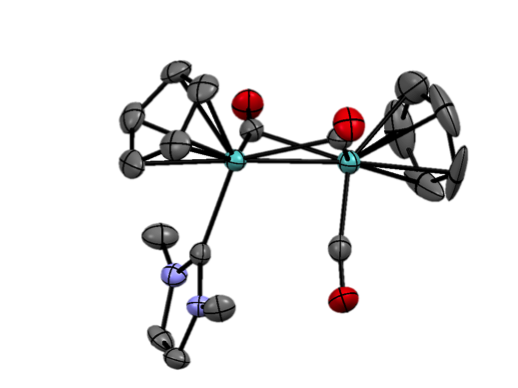57th Annual Report on Research 2012 Under Sponsorship of the ACS Petroleum Research Fund
Reports: ND349839-ND3: Novel N-Heterobicyclic Dicarbenes and C2-Symmetric Bicyclic Guanidinates as Dinucleating Ligands in Transition Metal Chemistry
Louis Messerle, PhD, University of Iowa
The aim of the PRF-supported research, continuing via alternate funding, was to prepare new alkylated dinucleating bicyclic guanidinate and neutral N-heterobicyclic dicarbene ligands for new classes of early transition metal-metal multiply-bonded complexes for small-molecule activation. One of the target alkylated hpp– derivatives is the C2-symmetric 4,10-Me2hpp–, which would give single isomers when two or more are coordinated in a dinuclear framework. The ligand architectures are based on the bicyclic guanidinate hpp–, the deprotonated form of hexahydropyrimidopyrimidine or 1,5,7-triazabicyclo[4.4.0]dec-5-ene, that has led to interesting later transition metal dinuclear complexes. While NHC-like dicarbenes are known, none have an architecture to support dinucleation fro metal-metal bonding.
For the entire two-year project period, four specific tasks were accomplished and are ongoing:
(1) Syntheses of new tantalum hpp– complexes were used to optimize protocols with inexpensive hpp– before studying Ta chemistry of C2-symmetric alkylated hpp–. We prepared, characterized spectroscopically, and determined the solid-state structures of pseudo-octahedral Ta(hpp)Cl4, pentagonal bipyramidal Ta(hpp)2Cl3, pinkish-red piano-stool Cp*Ta(hpp)Cl3, and the first mid-valent Ta hpp complex (depicted below), orange-red, paramagnetic, piano-stool Cp*Ta(hpp)Cl2. The hpp ligand(s) chelate by both nitrogens in each complex. In all complexes, bridgehead carbon-to-bridgehead nitrogen distances are short and bridgehead nitrogens are planar, consistent with strong delocalization of the bridgehead nitrogen lone pair into the guanidinate and hpp-to-Ta charge transfer. The Ta compounds exhibit unusual photophysics, under study by the H. Gray research group at Caltech. Ta(hpp)2Cl3 and Cp*Ta(hpp)Cl3 can be reduced with sodium amalgam to dinitrogen-sensitive mid-valent ditantalum complexes undergoing further characterization. Our approach to hpp– transfer has led to new, modestly-soluble Zr and Hf non- and mono-Cp* hpp– complexes. We are now using the more-solubilizing Me4hpp– (vide infra) in Group 4 chemistry. A manuscript on the tantalum chemistry has been submitted to Organometallics.
(2) An optimized multi-step enantioselective synthesis of the C2-symmetric 4,10-dimethylhppH from L-alanine was executed, involving a key reductive amination step and successful crystallization to separate intermediate diastereomers. The final cyclization from chiral(*) triamine [H2N(CH2)2C*HMe]2NH to 4,10-Me2hppH was greatly improved with a guanidinium salt C1 reagent. The synthesis is being reproduced by another graduate student prior to journal submission. We have developed a reproducible, higher-yield synthetic route to Me4hppH, improving on a brief literature report on its synthesis with a problematic step, and are optimizing it prior to publication.
(3) A seven-step route from nitro-xylene to a tricyclic bis(formamidinium) dication with N-CHMe2 and N-Me3C groups was developed and the structure of the unusual dication (two BF4– counterions omitted in figure below) was determined by X-ray diffractometry. The bis(formamidinium) dication can be deprotonated with Li bases to form a lithiated dicarbene based on the symmetry of the NMR spectra and a single, broad (from Li+ coupling) low-field carbon-13 NMR resonance at d232. Crown ethers are unable to abstract Li+ from the dicarbene-Li(HMDS) adduct. Crystallization studies have to date given multiple crystallites. We have studied complexation of the lithiated dicarbene with Pd(II), Rh(I), Zr(III), and W(III) precursors.
(4) Since NHC complexes of the early transition metals are rare, we studied reactions of ring-unsaturated bis(N-R)imidazol-2-ylidene (R = Me, Me2Im; mesityl) and the ring-saturated bis(N-Me)dihydroimidazol-2-ylidene with the Mo¼Mo triply-bonded Cp2Mo2(CO)4 (1). The bulky NHCs give mononuclear Mo radicals CpMo(CO)2(NHC), some previously reported by other routes. The infrared spectra in the CO region of the Mo radicals with saturated and unsaturated NHC ligands exhibit changes in band positions consistent with some ¹-backbonding by the NHC ligands, a phenomenon suggested by recent literature in later transition metal complexes. CO substitution has been observed with 1 to give Cp2Mo2(CO)3(Me2Im) with a Mo¼Mo (~0.1 � longer than in 2). This is, to our knowledge, the first example of an isolated metal-metal multiply-bonded NHC complex. Two of the carbonyls are semi-bridging in the structure. The Me2Im appears to undergo facile bridge-to-terminal fluxional interconversion in solution, as the single cyclopentadienyl 1H NMR resonance at 25° splits into two at lower temperature. Dinuclear complexes with bridging NHC ligands are quite rare.
Two graduate students, Adil Mohammad (Me2hppH organic synthesis and initial Ta hpp– chemistry) and Ross Bemowski (dicarbene synthesis, Mo NHC chemistry), were supported by PRF funds. Dr. Mohammad is now an FDA staff scientist, after a postdoctoral stint at Purdue, while Mr. Bemowski is on track to earn his Ph.D. in August 2013. Two other graduate students, Thomas Wood and Justine Olson, supported as TAs, have worked on the organic and organometallic aspects of the project. They have been assisted by four undergraduate researchers, Katie Christ, Carol Schaff, Kevin Booth, and Kyle Sobeski. The non-supported students have had some of their materials and supplies costs covered by the PRF funding.














